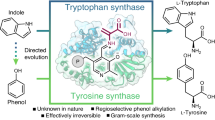Abstract
NEAR-ULTRAVIOLET light (320–400 nm) is lethal to bacteria1, yeast cells2 and mammalian cells3. A large body of evidence correlates cell death and survival with the induction and repair of pyrimidine dimers in the DNA of cells irradiated by far-ultraviolet light (200–300 nm) (refs 4–7). The induction of pyrimidine dimers has also been demonstrated by 365-nm near-ultraviolet light but at 7×105-fold lower efficiency than by 254-nm far-ultraviolet light8. With the exception of certain Escherichia coli strains with multiple deficiencies in DNA repair9,10 the small number of pyrimidine dimers produced by 365-nm near-ultraviolet light does not account for a significant fraction of the biological damage either in terms of lethality11 or the inactivation of transforming DNA12. The killing of cells by near-ultraviolet light is oxygen dependent whereas that by far-ultraviolet light is oxygen independent3,13. The operational distinction between far- and near-ultraviolet light based on oxygen dependence of lethality coincides with the upper limit of ultraviolet light absorption by the DNA at about 310nm14 and may reflect the involvement of a primary target site other than DNA in the killing of cells by near-ultraviolet light. In E. coli deoxyribonucleotides are formed de novo by the reduction of ribonucleoside diphosphates15. Two of the components of the ribonucleoside diphosphate reductase (RDP-reductase) complex, the non-haem iron protein subunit of the RDP-reductase16 and the functionally linked flavoprotein thioredoxin reductase17 have strong absorption in the near-ultraviolet region. I show here that near-ultraviolet irradiation of E. coli cells selectively destroys RDP-reductase activity in vivo and present evidence relating the loss of RDP-reductase to the loss of cellular viability and to the inability of irradiated cells to support the replication of DNA phages.
This is a preview of subscription content, access via your institution
Access options
Subscribe to this journal
Receive 51 print issues and online access
$199.00 per year
only $3.90 per issue
Buy this article
- Purchase on Springer Link
- Instant access to full article PDF
Prices may be subject to local taxes which are calculated during checkout
Similar content being viewed by others
References
Hollaender, A. J. Bact. 46, 531–541 (1943).
Fong, F., Peters, J., Pauling, C. & Heath, R. L. Biochim. biophys. Acta 387, 451–460 (1975).
Danpure, H. J., & Tyrrell, R. M. Photochem. Photobiol. 23, 171–177 (1976).
Setlow, R. B. & Carrier, W. L. Proc. natn. Acad. Sci. U.S.A. 51, 226–231 (1964).
Boyce, P. R. & Howard-Flanders, P. Proc. natn. Acad. Sci. U.S.A. 51, 293–300 (1964).
Setlow, R. B. Science 153, 379–386 (1966).
Setlow, R. B., Regan, J. D., German, J. & Carrier, W. L. Proc. natn. Acad. Sci. U.S.A. 64, 1035–1041 (1969).
Tyrrell, R. M. Photochem. Photobiol 17, 69–73 (1973).
Brown, M. S. & Webb, R. B. Mutat. Res. 15, 348–352 (1972).
Tyrrell, R. M., Webb, R. B. & Brown, M. S. Photochem. Photobiol. 18, 249–254 (1973).
Webb, R. B., Brown, M. S. & Tyrrell, R. M. Mutat. Res. 37, 163–172 (1976).
Peak, M. J., Peak, J. G. & Webb, R. B. Mutat. Res. 20, 143–148 (1973).
Webb, R. B. & Lorenz, J. R. Photochem. Photobiol. 12, 283–289 (1970).
Beaven, G. H., Holiday, E. R. & Johnson, E. A. in The Nucleic Acids (eds Chargaff, E. & Davidson, J. N.) 493–553 (Academic, New York, 1955).
Reichard, P. in The Biosynthesis of Deoxyribose 10–13 (Wiley, New York, 1967).
Brown, N. C., Eliasson, R., Reichard, P. & Thelander, L. Biochem. biophys. Res. Commun. 30, 522–527 (1968).
Moore, E. C., Reichard, P. & Thelander, L. J. biol. Chem. 239, 3445–34522 (1964).
Peak, M. J. & Peak, J. G. Photochem. Photobiol. 18, 525–527 (1973).
Maaloe, O. & Hanawalt, P. C. J. molec. Biol. 3, 144–145 (1961).
Warner, H. R. J. Bact. 115, 18–22 (1973).
O'Donovan, G. A. & Neuhard, J. Bact. Rev. 34, 278–343 (1970).
Cohen, S. S. & Earner, H. D. Proc. natn. Acad. Sci. U.S.A. 40, 885–893 (1954).
Breitman, T. R. & Bradford, R. M. Biochim. biophys. Acta 138, 217–220 (1967).
Munch-Petersen, A. Biochim. biophys. Acta 161, 279–282 (1968).
Hill, R. F. J. Bact. 71, 231–235 (1956).
Day, R. S. & Bernard, M. Photochem. Photobiol. 20, 95–102 (1974).
August, J. T., Cooper, S., Shapiro, L. & Zinder, N. D. Cold Spring Harb. Symp. quant. Biol. 28, 95–97 (1963).
Author information
Authors and Affiliations
Rights and permissions
About this article
Cite this article
PETERS, J. In vivo photoinactivation of Escherichia coli ribonucleotide reductase by near-ultraviolet light. Nature 267, 546–548 (1977). https://doi.org/10.1038/267546a0
Received:
Accepted:
Issue Date:
DOI: https://doi.org/10.1038/267546a0
Comments
By submitting a comment you agree to abide by our Terms and Community Guidelines. If you find something abusive or that does not comply with our terms or guidelines please flag it as inappropriate.



